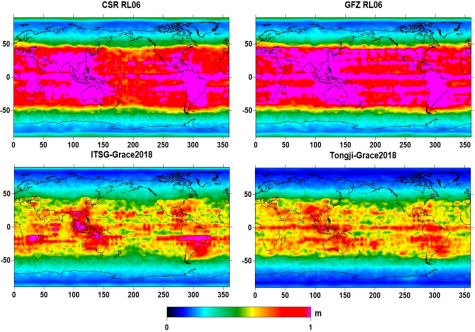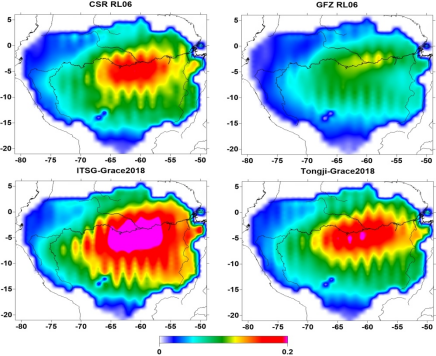An Optimized Short-Arc Approach: Methodologyand Application to Develop Refine Time Series of Tongji-Grace2018 GRACE Monthly Solutions
Qiujie Chen,YunzhongShen, Wu Chen,Olivier Francis, Xingfu Zhang,
Qiang Chen, Weiwei Li, Tianyi Chen
The Gravity Recovery and Climate Experiment (GRACE) mission was launched in March 2002, and continued to measure until the mission ended in October 2017 due to degradation of the batteries; over 15 years of measurements collected by the GRACE mission, it has provided rich satellite observation information for global surfaces quality migration changes, such as land water storage, ice mass loss over Antarctica and Greenland, sea level changes and earthquake coseismic variation. Recently, JPL (Jet Propulsion Laboratory) released the latest GRACE level1b RL03 observation data by using refined data processing methods. At present, the official institutions of GRACE, including the Center for Space Research (CSR), JPL, and GFZ (GeoForschungsZentrum), have solved the latest RL06 time-varying gravity field model using GRACE Level1B RL03 data. The Graz University of Technology in Austria also released the latest ITSG-Grace2018 time-variable gravity field model.
In view of the fact that the integration arc length of the short-arc integration method proposed by Chen et al. (2015) is only 2 hours, theoretical, the long-arc integration is more likely to suppress the impact of atmospheric and ocean dealiasing noise and observation errors and amplify the effect of small signals on LEO satellites, we further optimized the short-arc integration method on the basis of Chen et al. (2015). By drawing into position parameters into the boundary orbit of the integral arc segment and separating the GRACE orbits from the inter-satellite range observation equation, avoiding the direct inversion of the large-scale matrix, and effectively reducing the singularity of the normal equation, the integral arc length is successfully extended to 6 hours. As shown in Figure 1, the optimized short-arc integration method effectively reduces the high-frequency noise of the time-variable gravity field model compared with the method of Chen et al. (2015).

Figure 1. Gravity field solutions in terms of geoid degree variances w.r.t
EIGEN-6C4 determined by using the modified and optimized short-arc method.
Based on an optimized short-arc integration approach, Tongji Universitysolved the latest time-variable gravity field model Tongji-Grace2018 (up to degree and order 96) was derived from the GRACE Level1b RL03 observation data for the period April 2002 to August 2016. And then, we compared and analyzed the differences between the Tongji-Grace2018 model and official GRACE models in terms of spectra, time, and space domains. As shown in Figure 2, the Tongji-Grace2018 model is comparable to ITSG-Grace2018, the low degree signal level (general below degree 30 to 40) of Tongji-Grace2018 is in good agreement with those models on CSR RL06 and GFZ RL06 models, both Tongji-Grace2018 and ITSG-Grace2018 were significantly suppressed the high-degree noise.

Figure 2.Geoid degree variances of various gravity field solutions w.r.t EIGEN-6C4
Based on the method of P4M6 decorrelation filtering, and after deducting the dominant signal terms (trend, acceleration, annual, semiannual, and S2 alias components) of global quality changes, the RMS values of global mass change residual are depicted in Figure 3, much smaller RMS values at medium- and low-latitude areas are clearly observed in both Tong-Grace2018 and ITSG-Grace2018 compared to the official GRACE models.

Figure 3.RMS values of global mass change residuals of GRACE models processed by decorrelation filtering
Both Tongji-grace2018 and ITSG-Grace2018 models significantly suppress high-frequency noise compared with official GRACE RL06 models. Therefore, Tongji-Grace2018 and ITSG-Grace2018 based on 250-km Gaussian smoothing are close to the other two models based on 300-km Gaussian smoothing. Figure 4 shows the resulting time series of mass changes at different area basins with Amazon, Mississippi, Irrawaddy, and Taz basins by comparing the Tongji-Grace2018, ITSG-Grace2018, and three official GRACE models, we can see that the change signals of these models are very close. However, the mass changes at the amazon basin noise ratio of Tongji-Grace2018 and ITSG-Grace2018 models in the watershed is higher than that of the official GRACE RL06 models as shown in figure 5.

Figure 4. Time series of mass changes over river basins derived from mascon solution and filtered GRACE models

Figure 5. Signal-to-noise ratio values of mass changes over Amazon basin for different GRACE models
This study is primarily sponsored by the National Natural Science Foundation of China (41731069 & 41674006), the National Key R&D Program of China (2017YFA0603103), andthe Alexander von Humboldt Foundation in Germany.
Citation:
Chen Qiujie, Shen Yunzong, ChenWu, Francis Olivier, Zhang Xingfu, Chen Qiang, Li Weiwei, Chen Tianyi (2019). An optimized short-arc approach: methodology and application to develop refined time series of Tongji-Grace2018 GRACE monthly solutions. Journal of Geophysical Research, 124,https://doi.org/10.1029/2018JB016596

